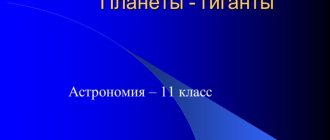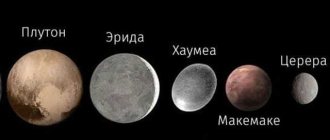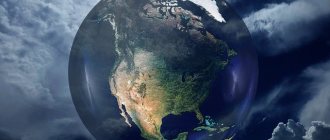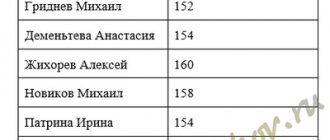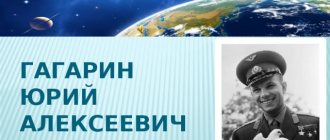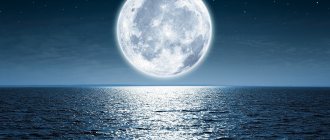Project "Planets of the Solar System"
- February 8, 2018
International and All-Russian competitions
All-Russian conference “Young researcher: project activities of junior schoolchildren”
Presentation of the project “Planets of the Solar System”
« Slide number 1. Good afternoon! I would like to introduce you to my project “Planets of the Solar System”.
Slide number 2
Every person loves to look at the stars. I'm also interested in space! After all, there are so many mysterious and unknown things there!
In the lesson “The world around us”, we got acquainted with the planets of the solar system and constellations. It is very interesting! And I wanted to learn more about space and the solar system. Therefore, I decided to collect as much information as possible about this in the Planets of the Solar System project.
Slide number 3
Project goal: Expand your knowledge about space. Collect interesting information about the solar system.
To do this, I need to find answers to the questions:
- How and when was the Universe formed?
- Find out what is the center of the solar system?
- Find out how many planets are in the solar system and what are they called?
- Create a model of the solar system;
- Find interesting facts about the solar system.
Slide number 4
Work on the project was divided into 3 stages.
At the first stage, we began collecting information from various sources: books, Internet sources, educational programs.
Slide number 5
How and when did the Universe originate? The universe began more than 15 billion years ago as a result of the Big Bang. Before the explosion, the substance was compressed almost to a point. Having exploded, it scattered with enormous force and speed.
Slide number 6
Giant clouds of gas and dust formed from the scattered matter; as they cooled, they became denser and turned into stars. Presumably, the matter remaining after the explosion, under the influence of gravity, formed different GALAXIES, in one of which we live.
Slide number 7
Our galaxy, called the Milky Way, is a giant spiral galaxy filled with stars, star clusters, gas and dust. There are so many stars in it that a person cannot count in his entire life. Our Galaxy is constantly rotating, but very slowly.
Slide number 8
After the “Big Bang”, the shock wave was so strong that the gas-dust cloud began to rotate strongly and was divided into 10 or 11 clusters of substances, which after separation were called PROTOPLANETS.
Slide number 9
As a result of the explosion, a large and very hot star was formed in the center of the galaxy, a huge, hot ball - the Sun. PROTOPLANETS revolved around the Sun.
Slide number 10
At first they became very hot, but then gradually cooled down and turned into the planets that we know today.
Slide No. 11 Mercury is the SMALLEST PLANET, moves faster than other planets, being burned by the sun's rays during the day and freezing at night.
Slide No. 12 Venus is more similar to Earth in size and brightness. Observing it is difficult due to the clouds enveloping it. The surface is a hot rocky desert.
Slide No. 13 The Earth was formed from a gas and dust cloud, like other planets. Particles of gas and dust collided and gradually “grew” the planet. Then the Earth cooled and became covered with a hard rock crust. Only on earth there is water. That's why life exists here. It is located relatively close to the Sun in order to receive the necessary heat and light, but far enough so as not to burn out.
Slide No. 14 Mars is the RED PLANET. Because of its resemblance to Earth, it was believed that life existed here. But the spacecraft that descended to the surface of Mars found no signs of life. This is the fourth planet in order.
Slide No. 15 Jupiter is a GIANT PLANET! It is more than twice as massive as all the planets in the solar system combined.
Slide No. 16 Saturn is a gas giant, almost as big as Jupiter.
Slide No. 17 Uranus is a unique planet in the solar system. Its peculiarity is that it rotates around the Sun not like everyone else, but “lying on its side.” Uranus also has rings, although they are harder to see.
Slide No. 18 Neptune - Among the four gas giants (Jupiter, Saturn, Uranus and Neptune), it is the smallest, coldest, most distant and windiest. At the moment, Neptune is considered the last planet in the solar system. Its discovery took place through mathematical calculations, and then it was seen through a telescope.
Slide number 19
There are eight planets in our solar system, and they all revolve around the sun in the same direction and in their orbit. The gravitational force of the huge Sun holds the planets like an invisible rope, preventing them from breaking free and flying into space. The first four planets: Mercury, Venus, Earth, Mars - consist of rocks and are located quite close to the Sun. They are called terrestrial planets . You can walk on the solid surface of these planets.
The other four planets: Jupiter, Saturn, Uranus, Neptune consist entirely of gases. If you stand on their surface, you can fall through and fly right through the entire planet. These four gas giants are much larger than the terrestrial planets, and they are located very far from each other. WHAT CAN YOU SAY ABOUT THE PLANET PLUTO?
Slide number 20
For a long time it was believed that the most distant planet in our solar system is Pluto, which is located beyond Neptune.
Slide number 21
But not so long ago, scientists decided that Pluto still cannot be considered a planet; many scientists consider it a satellite of the planet Neptune.
Slide number 22
Since 2006, there have been 8 planets in the solar system.
Slide number 23
Having studied in detail the information about the Planets of the Solar System, we began to create a model of the “Solar System”.
Slide number 24
This is the layout of the “Solar System” we have created! Using this model, you can observe how the planets move around the Sun.
Slide number 25
Do you know what a parade of planets is?
The parade of planets is an event of amazing beauty in which several celestial bodies find themselves on the same line. To the person observing what is happening, it seems as if the planets are located very close to each other.
Slide number 26
The parade of planets can be small or large. The minor parade of planets is the configuration of Mars, Mercury, Venus and Saturn , while they stand on one side of the star. This happens no more than once a year. A parade of three planets sometimes happens even several times a year, although the conditions for their visibility are different everywhere.
Big parade of planets . With this astronomical phenomenon, six celestial bodies appear on the same line at once, such as Venus, Mars, Earth, Saturn, Jupiter and Uranus . This magnificent spectacle can only be seen once every twenty years.
Using our layout, you can create any parade of planets: large or small.
Slide number 27
We found many interesting facts about our Universe.
Every year forty new stars are born in our Galaxy alone, imagine how many stars are born in all galaxies!
Slide number 29
In the vastness of the Universe there is a very amazing thing - a GIANT GAS BUBBLE. It was formed after the Big Bang.
Slide number 30
The sun “loses weight” by a billion kilograms per second, this happens from the solar wind.
Slide number 30
And most importantly, scientists believe that planet Earth has a twin, a celestial body similar to Earth. But which planet is a double - Gloria or Titan? Both planets are similar to our Earth. Scientists have to find out.
Slide number 31
The starry sky has always interested people, even those who lived in the Stone Age. Today, people study the Universe, both from Earth and from space, with the help of telescopes, artificial satellites, and spacecraft.
How many solar systems similar to our Earth could have formed in the Universe? On how many planets could life originate? Recently, even on Earth, previously unknown organisms have been discovered that are capable of living in areas that were previously considered uninhabited - ice caps, the depths of the sea, the bowels of the Earth and even volcanic craters. Nowadays there is a lot of talk about how life on Earth is becoming crowded.
Having studied the planets, we have not learned whether it is possible to find a planet suitable for life, if such a need arises. And what conclusion follows from this? We will continue to dream, listen and search...
Sooner or later, the answer will come from the beautiful distance of space!
Presentation of the project “Planets of the Solar System”
Terrestrial planets
The terrestrial group is located closer to the Sun. Its planets have a rocky structure and high density, making them smaller in size than the gas giants.
Mercury
Mercury
The planet closest to the Sun is also the smallest in the system. Its radius is only 2440 km. It received its name in honor of the god of trade, Mercury. Its surface is gray, which is why many compare it to the Moon. The planet does not contain satellites, and due to strong solar winds its atmosphere is almost completely discharged.
Venus
Venus
The second planet from the Sun, is named after the ancient Roman goddess of love. Distinctive features are the absence of natural satellites and the high content of carbon dioxide in the atmosphere. The radius of Venus is almost identical to that of Earth: 6051 km, which is only 5% less. Because of this, the planets are called “sisters”. However, Venus is very different in appearance, appearing as a milky ball. The surface consists almost entirely of hardened lava with rare craters from meteorites.
Earth
Earth
The third planet from the Sun, the only one where there are large territorial areas filled with water. Due to favorable climatic conditions and sufficient resources, it is the only source of life in the solar system. The radius of the planet is 6378 km.
Interesting: Why is Pluto not a planet? Description, status, photo and video
Mars
Mars
“Red” planet is the farthest from the Sun, belonging to the terrestrial group. It is also considered the smallest after Mercury. Its radius is 3396 km. The surface consists primarily of sandy and earthen landforms, divided into light and dark areas called continents and seas, respectively. In the 21st century, Mars is of great interest to scientists. Because the planet is relatively within reach, rovers are regularly sent to collect data.
Colonization
In the 20th century, people began to actively explore space, not only observing it from telescopes, but also launching various satellites, shuttles, rockets, etc. Scientists are also searching for planets favorable for life. Unfortunately, a cataclysm may occur on Earth at any moment, due to which humanity will have to look for a new home. Therefore, the possible colonization of space is not an empty phrase for modern observatories.
Interesting: The Sun, planets and gravity - description, photo and video
Even in the last century, probes were sent to various planets, still transmitting information about their journey. This helps to better understand the structure and features of solar system objects.
Traces of the rover on the surface of Mars
As for direct colonization, in the 21st century it is already in the order of things to send lunar rovers and rovers that walk on the surfaces of the earth’s satellite and the fourth planet in search of life and other unusual finds. However, now humanity is still on the threshold of space travel, so there is no need to talk about potential relocation to another planet yet. Moreover, most of the large bodies in the solar system are not suitable for life.
